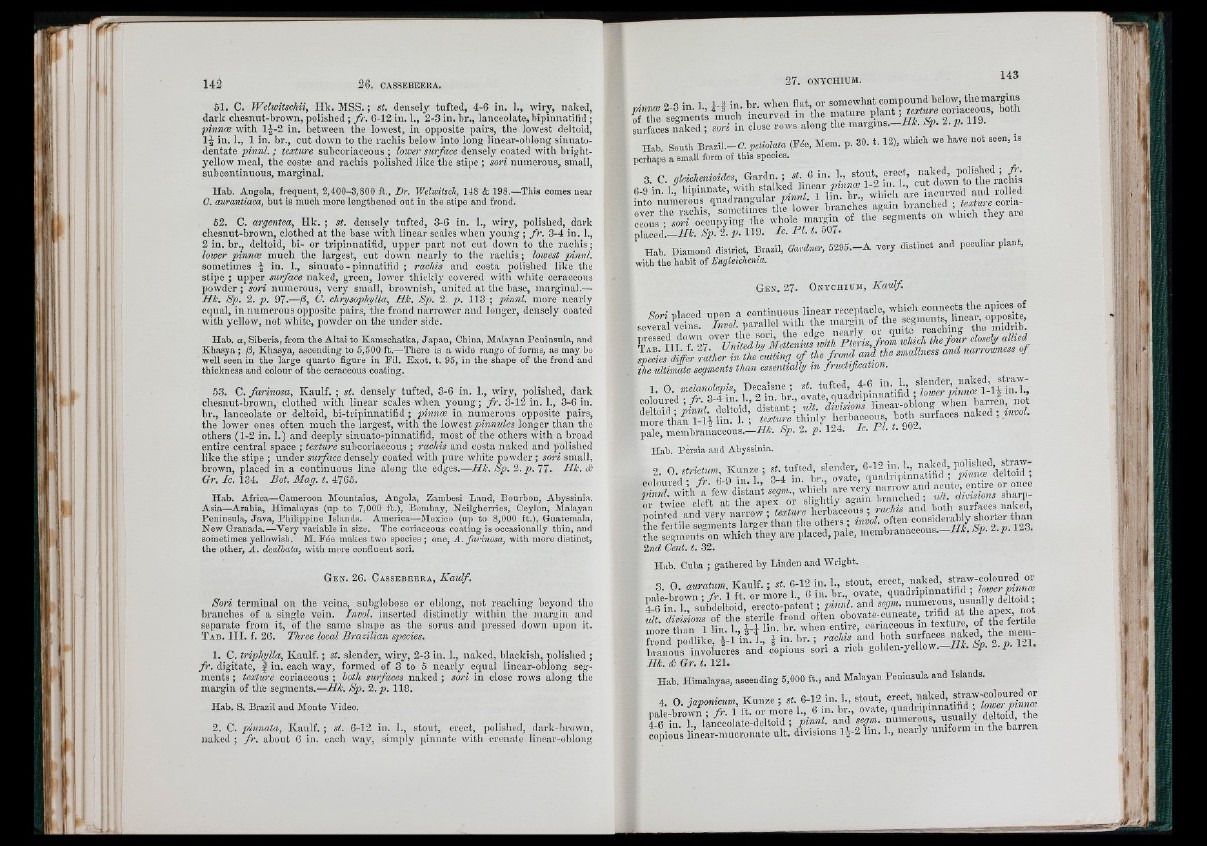
i!'
142 20. CASSEBEERA.
51. C. Welwitschii, I lk . MSS. ; st. densely tufted, 4-6 in. 1., wiry, naked,
d a rk chesnut-brown, polished ; f r . 6-12 in. 1., 2-3 in. hr., lanceolate, bipinnatiHd ;
pnnnæ with lJ -2 in. between the lowest, in opposite pairs, the lowest deltoid,
I J in. ]., 1 in. br., cut down to the rachis below into long linear-ohlong sinuato-
dentate pinnl. ; texture subcoriaceous ; lower surface densely coated with bright-
yellow meal, the costæ and racliis polished like tlie stipe ; sori numerous, small,
subcontinuous, marginal.
Hab. Angola, frequent, 2,400-3,800 ft., Dr. Wdxmtsch, 148 & 198.—This comes near
C. aurantiaca, but is much more lengthened out iu the stipe and frond.
52. C. argentea, H k . ; st. densely tufted, 3-6 in. 1., wiry, polished, dark
chesnut-brown, clothed a t tlie base with linear scales when young ; f r . 3-4 in. 1.,
2 in. hr., deltoid, bi- or tripinnatifid, upper p a rt not cut down to the racliis ;
lower pinnæ inucli the largest, cut down nearly to tlie rachis ; loioest pinnl.
sometimes J in. 1., sinua to-p in n a tifid ; rachis and costa polished like the
stipe ; upper surface naked, green, lower thickly covered with wiiite ceraceous
poivder ; sori numerous, very small, brownish, united at the base, marginal.—
H k . Sp. 2. p . 97.—(3, 0. chrysophylla, H k . Sp. 2, ¡o. 113 ; pinnl. more nearly
equal, in numerous opposite pairs, the frond narrower and longer, densely coated
with yellow, not white, powder on the under side.
Hab. a, Siberia, from the Altai to Kamsohatka, Japan, China, Malayan Peninsula, and
Khasya ; f t Khasya, ascending to 5,500 ft.—There is a wide range of forms, as may bo
well seen in the large quarto figure in Fil. Exot. t. 95, in the shape of the frond and
thickness and colour of the ceraceous coating.
63. C. farinosa, Kaulf. ; st. densely tufted, 8-6 in. L, wiry, polished, dark
chesnut-hrown, clothed rvith linear scales when y o u n g ; f r . 3-12 in. 1., 3-6 in.
hr., lanceolate or deltoid, bi-tripinnatifid ; pinnoe in numerous opposite pairs,
the low'er ones often much the largest, with the lowaat pinnules longer th an the
others (1-2 in. 1.) and deeply sinuato-pinnatifid, most of the others with a broad
entire central space ; texture subcoriaceous ; rachis and costa naked and polished
like the stipe ; under surface densely coated with pure white powder ; sori small,
brown, placed in a continuous line along the edges.—H k . Sp. 2. p . 77. H k . £
Gr. Ic. 134. Bot. Mag. t. 4766.
Hab. Africa—Cameroon Mountains, Angola, Zambesi Land, Bourbon, Abyssinia.
Asia—Arabia, Himalayas (up to 7,000 ft.), Bombay, Neilgherries, Ceylon, Malayan
Peninsula, Java, Philippine Islands. America—Mexico (up to 8,000 ft.), Guatemala,
New Granada.—Very variable in size. The coriaceous coating is occasionally thin, and
sometimes yellowish. M. Fée makes two species ; one, A. fax'inosa, with more distinct,
the other, A . dealbata, with more confluent sori.
Gen. 26. Cassebeera, K a u lf.
Sori terminal on the veins, subglobose or ohlong, not reaching beyond the
branches of a single vein. Invol. inserted distinctly within the margin and
separate from it, of the same shape as the sorus and pressed dow’n upon it.
T ab. I I I . f. 26. Three local Brazilian species.
1. C. triphylla, Kaulf. ; St. slender, wiry, 2-3 in. 1., naked, blackish, polished ;
f r . digitate, j in. each w’ay, formed of 3 to 5 nearly equal linear-oblong segments
; texture coriaceous ; both surfaces naked ; sori in close rows along the
margin of thfe segments.—H k . Sp. 2. p . 118.
Hab. S. Brazil and Monte Video.
2. C. pinnata, Kaulf. ; st. 6-12 in. 1., stout, erect, polished, dark-hrown,
naked ; f r . about 6 in. eacli way, simjily pinnate witli crenate linear-olilong
• 9 “ in 1 i-ff in hr. when flat, or somewhat compound below, the margins
r le s'eg n e n foU ic li incurved in the mature " ® ° ? T l9
¿ufaces naked ; sori in close rows along the m a r g in s .- / f t . Sp. 2. p . 119.
Hab. South Brazil.-C. pdioiato (Fée, Mem. p. 80. t. 12), which we have not seen, is
perhaps a small form of this species.
p l a c e d .- / / / . Sp. 2. p . 119. Ic. B l. t. 507.
Hab. Diamond district, Brazil, Gardntt, 5 2 9 5 .-A very distinct and peculiar plant,
with the habit of Eugleichema.
G e n . 27. O n y c h i u m , Kaulf.
the ultimate segments than essentially in fructification.
1. 0 . melanolepis, Deca isne; ai. tufted, 4-6 I”,
pale, inenibraiiaceons.—Ilh . Sp. 2. p. 1-4. Ic. . •
Hab. Persia and Abyssinia.
the segments on which they are placed, pale, niemhi aiiaceous. p
2nd Cent. t. 32.
Hab. Cuba ; gathered by Linden and Wnght.
hranous involucres and copious son a rich golden-yello . ■ P P
Hk. £ Gr. t. 121.
Hab. Himalayas, ascending 5,000 ft., and Malayan Peninsula and Islands.
è J i è L k e ^ i ^ u ^ ^ i t o e ^ k d bisions 1J-2 L . !.. nearly uniform in the barren
rl